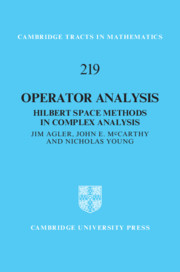Operator Analysis: Hilbert space methods
in Complex Analysis
By Jim Agler, John E. McCarthy and Nicholas Young
 Contents
on Cambridge University Press Website
Contents
on Cambridge University Press Website
Corrections
We are very grateful to Orr Shalit for carefully reading the book, and catching most of the following mistakes.
P. 30, Line 17: The reference should be to von Neumann's 1929 paper, [209].
P. 62, Line 9-: ker($\mathbb D$) should be Her
($\mathbb D$)
P. 82, Line 4: $u$ is a rational map from $\mathbb D$ into $\mathcal{ B(H,M)}$.
P. 101, Line 9: The third term on the left-hand side should be $L(\lambda - \lambda_0) \gamma$.
P. 101, Line 7-: The = should be $\geq$.
P. 103, Line 6: $\mathcal{W_{B(X)}}$ should be just $\mathcal{W}$.
P. 106, Line 1-: orthogonal projections should be orthogonal complements.
P. 114, Lines 7- to 1-: three of the $\mathbb{D}^2$ should be $\mathbb{D}^2 \times \mathbb{D}^2$.
P. 149, Line 7: $h$ should be $f$ in Eq. 6.6.
P. 171, Line 5: $\mu$ should be $\bar \mu$.
P. 191, Line 3-: $\theta_T$ should be $\sin(\theta_T)$.
P. 213, Line 2: Delete "with".
P. 217, Line 16: There should be no square on $\Vert \phi \Vert_{{\mathbb D}^2}$.
P. 243: "subordinate to $\mathbb{D}$" should be "subordinate to $\mathbb{D}^d$.
P. 263: Line 12: It should be (10.27) that is called the primal;
(10.28), using the matrix $A$ from (10.27), is the dual problem.
P. 270: Line 18: $\Delta$ is in $SA{\mathbb M}_n^d$.
P. 273: Line 13: Should be "that $0 \leq t \leq \varepsilon$,".
P. 288: Line 7-: ${ d \choose 2}$ should be ${n \choose 2}$.
P. 299: Line 8: "their ampliations" should be "its ampliations".
P. 326, Line 9: add " and $B_\delta \subseteq \Omega$."
P. 332, Line 14: ${\mathcal M}^d$ should be ${\mathbb M}^d$.
P. 337, Line 13: Indeed, the boundary of $\Phi( Ball(a^(k), r))$ is disjoint from
$Ball(b^{(k)},s)$, so the latter must be in its interior.
P. 340, Line 3: Missing comma.
P. 346, Line2: "domain" should be "function".
P. 350, Line 8: "dense" should be "sequentially dense".
P. 354, Line 7-: This is bad notation. $A$ should be $\alpha$
throughout the proof. Unless $\delta(0) = 0$, $\alpha$ will in
general be distinct from $A$ in (16.30).
Last updated: October 13, 2020
Contents on Cambridge University Press Website
Contents on Cambridge University Press Website